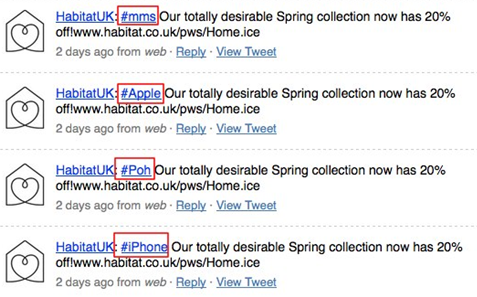As a social media teacher, it’s always gratifying to see more and more small business owners using social networks to amp up their business.
They’re beginning to realize that Tweeting isn’t just for gossipy teenagers and that -in fact – a lot of their customers hang out these kinds of social media spheres all day.
So it only makes sense to stop relying solely on the ‘push’ method of marketing (oh how 2001!) and instead start to mix in the ‘pull’ methods like Tweeting and Facebooking. Small biz owners are getting that message loud and clear.
The bad news? A lot of them are really blowing it.
In the wrong hands, social media can quickly turn on you. It can go from being a business’ smartest asset….to its hugest liability.

One of the most famous examples of this is the story of a bumbling, tweeting intern at a big UK store called Habitat. With just a few horribly spammy Tweets they suffered an enormous online backlash and dinged their previously excellent brand in the process. (Word is, the hapless intern was let go.)
What did they do that was so bad?
Well, they plugged popular hashtags (like #iPhone and #True Blood) in their promotional tweets. Even though those hashtags had NOTHING to do with what they were saying. Or should I say – what they were selling.
This is a perfect case of what happens when that pesky “push marketing” mentality invades a very “pull” marketing arena. Here’s a famous screencap sampling the now infamous tweets:
But that’s a big store. One that has enough corporate dollars to afford traditional marketing and doesn’t need to rely on social media the way smaller business owners might.
So how are we using it? And are WE doing it right?
According to a recent study by eMarketer and the University of Maryland, 75% of small businesses had a Facebook or LinkedIn page as of December 2009. That’s great! People are ‘getting it’!
But another stat in this report isn’t quite so encouraging. Though 54% of small businesses were using social networks to ‘monitor feedback about their organizations’ and 69% were ‘posting status updates’ – a mere 16% were using Twitter as a Customer Service channel.
In other words – they were talking about themselves far more than they were listening to their customers. Which is a cardinal sin in social media.
Listen: it’s called social media for a reason. It’s not business media. It’s social. It’s a dialogue, not a monologue. Not a sales pitch.
Do you have to answer each and every person who “@s” you in Twitter? No…but you should answer as many as you possibly can. Do you have to never mention your business and your promotions? No…but you better do so against a backdrop of lots of social, interesting talk with your customers.
Like I tell new social marketers all the time, Social Marketing may seem ‘free’…but it’s not. The same way that organic SEO isn’t really free. Sure, you don’t have to pull out your wallet and pay for it they way you do traditional advertising, but there’s a time-cost. You have to put in the time to really build relationships and be respectful and do it *right*.
Because – unlike most big businesses – you don’t have an intern to blame if you do it wrong. You only have yourself. So get this wrong and pay the price. (Can’t fire yourself can you?)
But get social media right and watch your sales, your brand and your customer goodwill skyrocket.




Look into cloud solutions like ZenDesk – they can take a Tweet and turn it into a ‘Twicket’ and do the same for blog comments as well. I stumbled onto this, as I am looking for a service/software solution to help me turn questions into user-generated content via a Knowledge Base. I’m also thinking of using a free Google Voice number to accept questions by phone and have the built-in (less than perfect, I know) transcription within Google Voice send an email of said question to something like ZenDesk to be addressed and/or added to the KnowledgeBase.
Thanks I agree with that. The result of social marketing is traffic. We need to invest our precious times and effort.